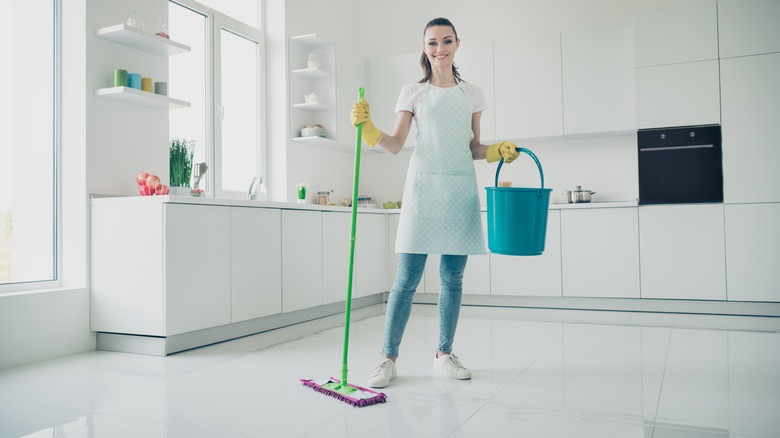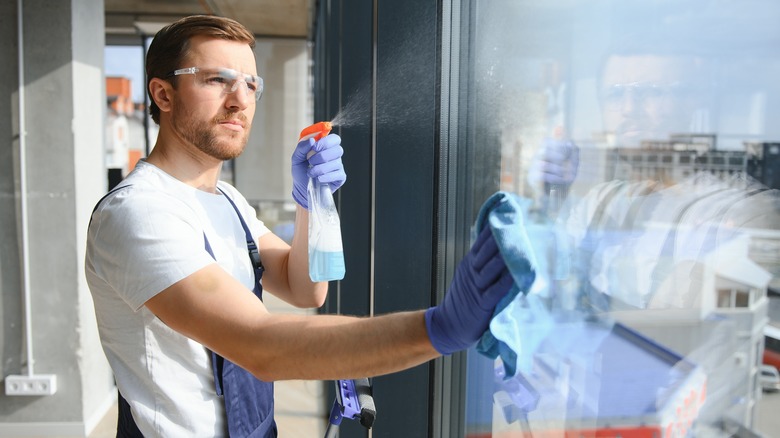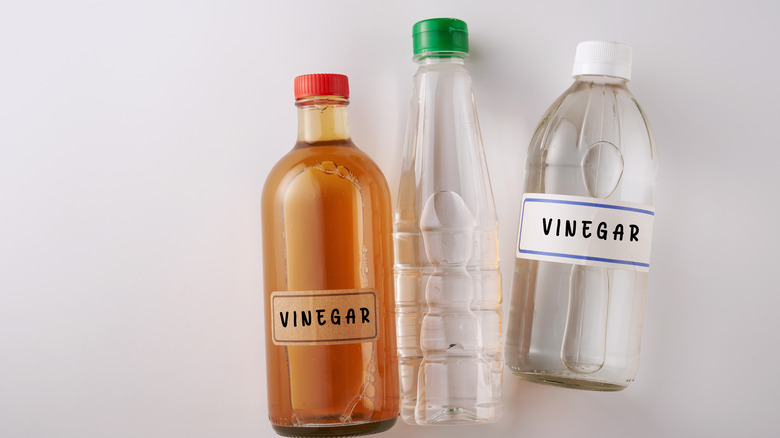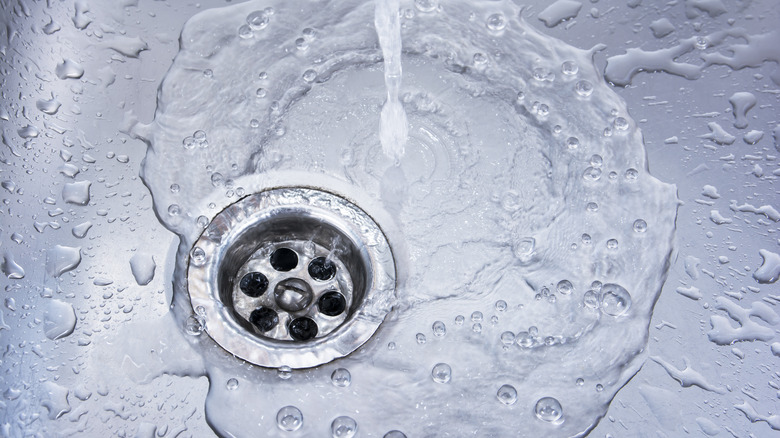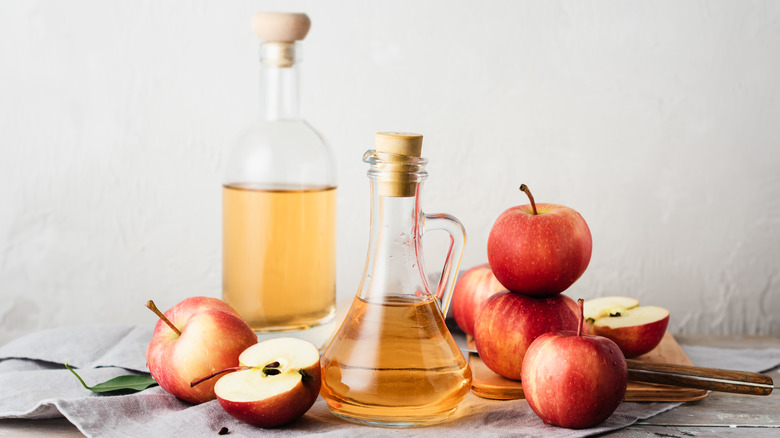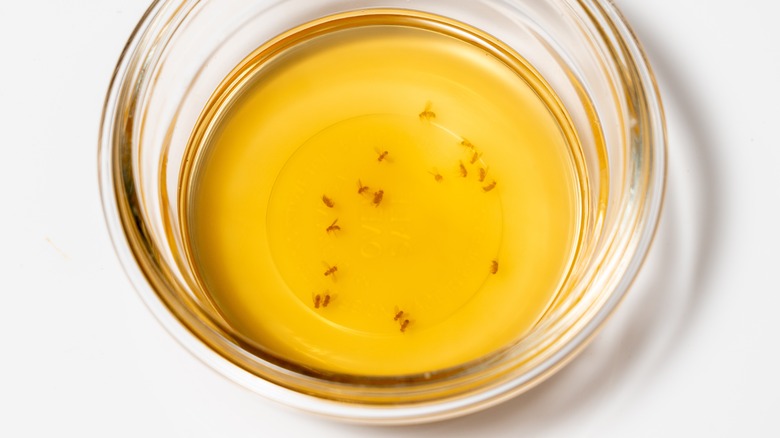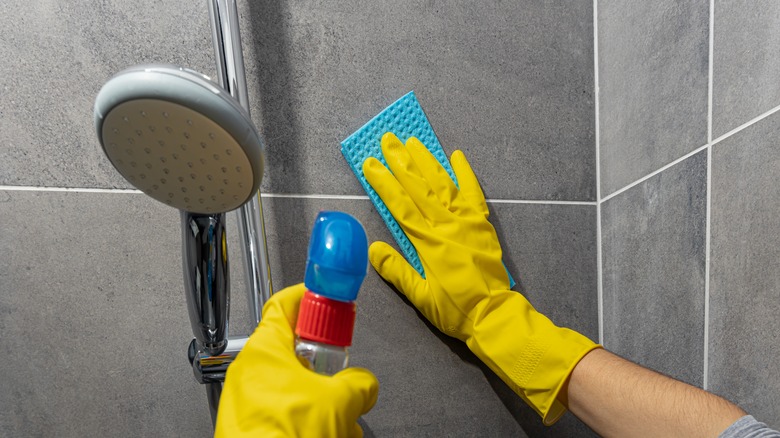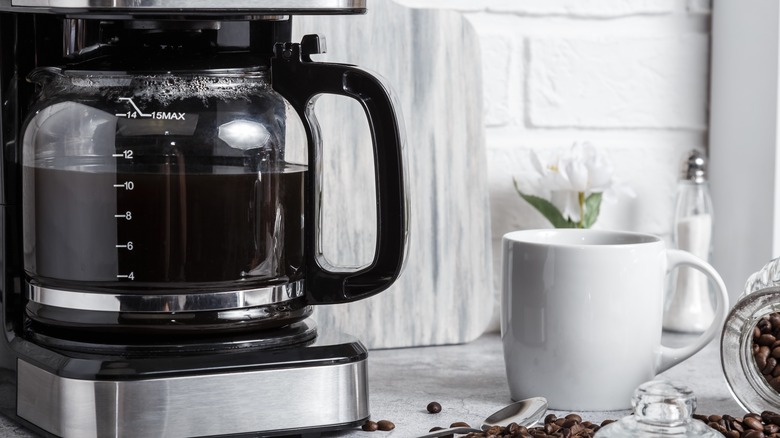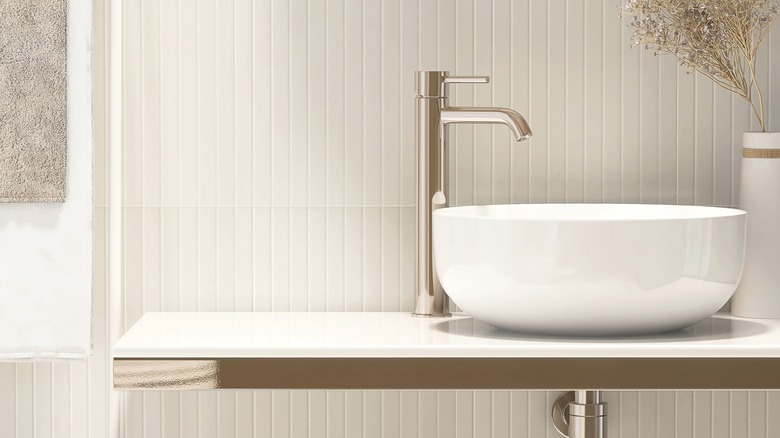9 Ways You Should Be Using Apple Cider Vinegar For A Cleaner Home
When it's cleaning day, you don't need to expose your home and family to the harsh chemicals in commercially prepared cleaners. Instead, you can reach for a natural cleaning ingredient that people have been using since the Babylonians invented it in 5000 B.C. Yes, apple cider vinegar has been around for that long. The modern-day product is made of at least 5 percent acetic acid dissolved in 94-95 percent water. It's made from apple juice that goes through a two-step fermentation process converting fruit sugar to alcohol and alcohol to acetic acid.
Apple cider vinegar is a nontoxic and environmentally friendly choice for your house cleaning chores. Diluted with water, it safely and effectively cleans floors, windows, mirrors, countertops, appliances, ceramic tile, porcelain, and other surfaces in the home. Combine apple cider vinegar with baking soda, and you can blast through clogs in drains and stopped-up toilets. We've rounded up a collection of cleaning tasks that apple cider vinegar can do for you. But we've also included information about when and where it might not be the best choice as a cleaner. Read on to discover more about this ancient formulation that's still in use today.
Reach for the apple cider vinegar to clean your floors
Although many people consider distilled white vinegar to be a versatile ingredient for cleaning your floors, you can safely substitute apple cider vinegar for the job. In fact, some people prefer the smell of apple cider vinegar over its clear counterpart. Both types of vinegar contain approximately 5 percent acetic acid, and it's this ingredient that gives vinegar its cleaning power. Additional benefits from cleaning your ceramic tile, laminate, and vinyl floors with apple cider vinegar include odor removal as well as a mild disinfecting action. However, you should avoid apple cider vinegar and instead use plain old white vinegar on hardwood floors to prevent discoloration. Avoid vinegar altogether on marble, granite, stone, and waxed wood floors. The acetic acid in vinegar could damage these materials.
Mop tile floors with a solution of 1⁄2 cup of vinegar to 1 gallon of warm water. If you have linoleum floors, increase the vinegar amount to 1 cup for every gallon of warm water. For prefabricated floors, mix ½ cup of vinegar to 1 gallon of hot water. As a cleaning technique, wring your mop thoroughly before each pass with the vinegar-and-water solution.
Put apple cider vinegar to work as a streak-free window cleaner
You'll feel better about cleaning when you know that the ingredients in your cleaning supplies are all-natural and nontoxic. For sparkling windows and mirrors, you need only two ingredients: apple cider vinegar and water. In a spray bottle, mix ¼ cup of vinegar with 2 cups of water. For a stronger solution, you can mix equal parts ACV and water. When you're mixing a batch of window cleaner, it's a good idea to use distilled water to ensure a long shelf life. Use either white vinegar or apple cider vinegar, as they work equally well for this purpose.
Start by wiping the window with a dry microfiber cloth to remove any loose dust. Then, spray the glass with the vinegar and water solution. Wipe immediately with paper towels or a microfiber cloth to reveal a clean window with no residual streaks. If you're trying to limit your use of paper towels, you can get good results from wiping the window with newspaper. When you're finished, throw the newspaper into your compost pile.
Make a cheap and natural all-purpose cleaner with apple cider vinegar
In addition to the peace of mind that you get from using natural ingredients to clean your home, apple cider vinegar offers a thrifty option that helps you save a bit on household expenses. Use it to mix a DIY all-purpose cleaner in a spray bottle. For a strong solution, mix equal parts ACV and water. Alternatively, you might use only ½ to 1 cup of ACV mixed with 2 cups of water. The acetic acid in the vinegar acts as a solvent to break down dirt and grime. It even kills some (but not all) bacteria. You can also add an essential oil to your DIY cleaner, giving the mixture a pleasant aroma.
Once you've concocted your all-purpose cleaner, you can use it as you would any commercial product. Spray it on surfaces in the kitchen and bathroom, including sinks, countertops, stoves, microwaves, toilets, showers, and bathtubs. Apple cider vinegar cuts through and removes soap scum as well as mineral deposits from hard water. Additionally, it acts as a mild disinfectant, but it doesn't kill E. coli or staphylococcus bacteria as well as commercial disinfectants do. Be aware that you should never apply your ACV all-purpose cleaner to marble, granite, and stone countertops or floors, as the acetic acid could mar these surfaces. As a warning, you should never mix vinegar with bleach or ammonia. It creates a harmful, toxic gas.
Unclog and freshen the drains in your kitchen and bathroom sinks
Do you remember that fifth-grade science project where you made a model of an erupting volcano using vinegar and baking soda? The acid-base reaction of the sodium bicarbonate with the acetic acid in the vinegar produced carbon dioxide gas that triggered the volcano-like action. Now you can put those same principles to work in your sink drains to blast away grimy residue and leave your drains clear and open.
To unblock a clogged drain, start by pouring in a pot of boiling water to begin loosening the clog. Next, pour in ½ cup of baking soda and let it settle. Follow up with 1 cup of ACV, and you'll see the mixture fizz and bubble. Leave the foaming substance in the drain for 15 minutes and finish up by rinsing it down with an additional pot of boiling water. If the clog is not completely cleared, repeat the process. You might use this freshening technique every week or two to keep your drain running freely and smelling fresh. Note that baking soda and vinegar don't work well together as a cleaning agent.
Apple cider vinegar helps to eliminate household odors, including the smell of pet urine
With the acetic acid in apple cider vinegar acting as a mild antibacterial agent, the solution offers deodorizing properties as it kills some of the bacteria that cause unpleasant smells. This is why using ACV as a cleaning agent offers the benefit of neutralizing household odors. To rid your kitchen of strong cooking smells, you can allow a pot of ACV to simmer on the stove for 20 minutes. As it simmers, the acetic acid from the vinegar turns into a vapor that bonds with the odor-causing molecules in the air. If you're trying to get rid of a smoky smell, simply mist the air with a mixture of 1 part apple cider vinegar to 1 part water.
Spraying a mixture of equal parts ACV and water directly onto the foul-smelling surfaces is an alternative method for odor control. For example, you can freshen a smelly garbage can by spraying the interior with the mixture and letting it sit for a minute before wiping with paper towels. Pet parents find that apple cider vinegar comes in handy for removing the lingering odor of pet pee in the house. After absorbing the urine with paper towels, spray the area with a mixture of 1 part ACV to 1 part water and let it sit for 5 minutes before blotting with paper towels. As an alternative to the vinegar-and-water solution, some cat lovers find success by treating the pet urine spot with undiluted, raw, and unfiltered ACV.
Trap fruit flies and gnats with apple cider vinegar before they infest your home
Even with window screens and AC-controlled home environments, the fruit flies and gnats somehow find their way indoors to torment us during the spring and summer seasons. When those little pests show up, there's a simple solution to the problem. Make a few traps and set them around the kitchen or wherever you notice the insect activity.
Mix 1 tablespoon of sugar, 2 tablespoons of ACV, ½ cup of water, and a few drops of liquid dish soap in a small bowl. Set it on your kitchen countertop, and notice that the fruit flies and gnats are attracted to the sweet and pungent mixture. But once they land in the liquid, they're unable to escape due to the sticky texture of the dish soap. A simplified recipe includes only apple cider vinegar and a few drops of dish soap as the ingredients for the trap. Note that apple cider vinegar may work as a short-term repellent for mosquitoes, spiders, and ants as well. But the effect is only temporary, and ACV should not be considered a reliable treatment to keep those pests out of your home in the long term.
Kill mildew with a blast of apple cider vinegar
According to the U.S. Environmental Protection Agency, mildew is a type of mold or fungus that grows in moist environments. If left unchecked, it can continue to grow in your home, typically inhabiting bathrooms, basements, and closets. Mildew emits a strong, musty odor, and breathing in the spores can be unhealthy for you and your family. That's why it's important to clean mildew as soon as you notice it growing on bathroom walls, window sills, and on the surfaces of items stored in closets, attics, and basements. The acetic acid in apple cider vinegar kills the mildew fungus.
Although bleach is a well-known mold killer, you may not want to introduce the fumes from bleach into your home environment. That's where ACV comes in as a viable alternative to the harsh irritants in bleach. To remove mildew from surfaces in your home, simply apply straight, undiluted apple cider vinegar and allow it to sit for 1 hour before rinsing and drying. The easiest application method is to pour the vinegar into a spray bottle and spray it directly onto the mildew. To maintain mildew-free surfaces in moist areas, you can follow up by cleaning regularly with a diluted solution of ACV and water.
Use ACV to clean and descale your coffee maker
For many of us, that morning cup of coffee is a vital necessity that kicks off our day. But when was the last time you cleaned and descaled your coffee maker? It is beneficial to deep-clean your coffee maker once a month. Both white and apple cider vinegars are natural, effective cleaning agents for the job. The acetic acid content in either product will cut through the stains, coffee-oil residue, and soap scum to leave the machine in pristine condition.
To clean the inner workings of your coffee maker, start by filling the carafe with a solution of 1 part ACV and 2 parts water. Pour it into the machine and let it run through a brewing cycle. Allow the liquid to sit for 10-15 minutes before pouring it out. Then, run clear water through the machine for at least 2 or 3 additional cycles. Alternatively, you can turn off the coffee maker when it is halfway through the brewing cycle and allow the vinegar solution to sit for 30 minutes. This ensures a thorough descaling of the water lines. Then, turn on the machine to finish the cycle. The downside of using apple cider vinegar to clean and descale a coffee maker is that it has a strong smell and taste that, if left behind, can interfere with the taste of your coffee. For this reason, it's important to run several cycles of clear water through the machine before you put it to work brewing your next pot of coffee.
You can use apple cider vinegar to clean some parts of your bathroom
When it comes to cleaning your bathroom, you not only want to kill mildew and produce sparkling clean surfaces, it's also important to use a bathroom cleaner that kills germs. With around 5 percent acetic acid content, apple cider vinegar is considered a mild disinfectant that kills some types of bacteria. But to produce a strong antibacterial effect, the acetic acid would need to be at the 10 percent level. For this reason, you should only rely on apple cider vinegar to clean surfaces, not to disinfect.
Dilute apple cider vinegar with water in a 1:1 ratio to clean ceramic tile and porcelain bathroom fixtures. The acetic acid dissolves hard water deposits and soap scum. Be careful to keep ACV away from marble or granite countertops. You can make a simple bathtub cleaner using only castile soap and apple cider vinegar. Mix them at a 1:1 ratio and dispense into a spray bottle. Spray liberally and let sit for 30 minutes before wiping with a sponge.

